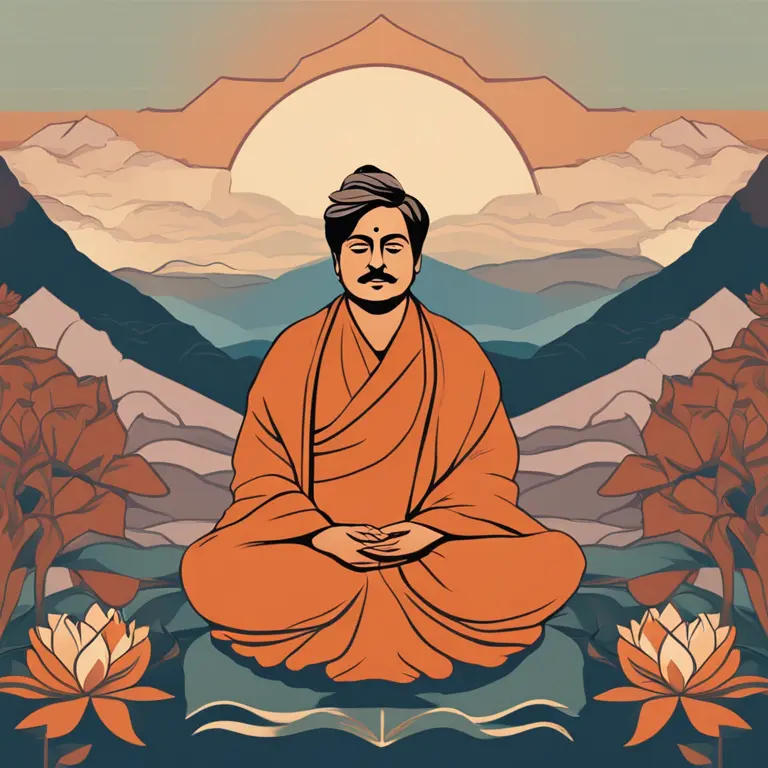
Swami Vivekananda's Meditative Insights
Delve into Swami Vivekananda's meditation techniques that promote inner peace and spiritual growth, shaping minds for the modern world.
article by Hina Kurosawa
Swami Vivekananda and Meditation
Swami Vivekananda, a key figure in the introduction of Indian philosophies of Vedanta and Yoga to the Western world, emphasized meditation as a powerful tool for personal transformation. Born as Narendranath Datta in 1863, Vivekananda was a disciple of Ramakrishna Paramahansa and became an influential spiritual leader. His teachings on meditation are as relevant today as they were over a century ago, providing pathways to tranquility and self-realization. Vivekananda's approach to meditation bridges the gap between ancient wisdom and modern practices, allowing contemporary seekers to tap into timeless techniques.

Starting with Concentration
According to Vivekananda, the foundation of meditation lies in concentration. He believed that training the mind to focus on a single thought or object was essential for achieving deeper states of consciousness. Vivekananda's concentration techniques involve starting with simple objects and gradually progressing to more complex ideas. This step-by-step approach is aimed at harnessing the mind's wandering nature and steering it toward a pointed focus, eventually leading to a meditative state where the mind transcends all thoughts.

Posture and Environment
Swami Vivekananda specified that a proper posture and conducive environment play significant roles in successful meditation. He recommended sitting upright, with the spine straight, to aid in concentrating the mind's energies. Vivekananda advised that the place of meditation be clean, quiet, and free of disturbances. In today's bustling lifestyle, creating a peaceful sanctuary for meditation practice is even more crucial, as it allows for a retreat from the distractions of the modern world and enables deeper focus.

The Power of Breathing
Breathing techniques were also a core aspect of Vivekananda's meditation practice. He stressed the importance of controlled breathing (Pranayama) as a means of calming the mind and preparing it for meditation. Slow, deep breaths help in regulating the flow of prana or life energy, which is thought to positively influence one's mental and physical states. Contemporary science supports this view, recognizing the benefits of deep breathing for stress reduction and overall well-being.

Mantra and Visualization
Mantra repetition and visualization are methods that Swami Vivekananda recommended to focus the mind. He suggested choosing a sacred word or phrase (mantra) that holds personal significance and silently repeating it during meditation. Visualization, or the practice of forming mental images, aids in concentration and deepening the meditative experience. These techniques are instrumental in achieving a state of inner stillness amidst the chaos of everyday life.
Meditation as a Lifestyle
For Vivekananda, meditation was not just a practice but a way of life. He encouraged his followers to incorporate meditative principles into their daily routines. This involves living with awareness, being present in every moment, and acting with intention. The modern interpretation of Vivekananda’s teachings highlights the adaptability of meditation to fit the dynamic and diverse lives of people across the globe, enhancing mindfulness and inner peace.
Beyond Boundaries
Swami Vivekananda's meditative teachings transcend religious and cultural boundaries, offering universal techniques that can benefit all individuals. In our inter-connected world of 2024 and beyond, his inclusive approach to meditation serves as a bridge between various spiritual practices, inviting people from all walks of life to explore the depths of their own consciousness and connect with the universal human experience.
Published: 2/12/2024
Modified: 2/12/2024
More predictions
Come back here soon to learn more about yourself and your future


Calming the Mind: Meditation Practices for Anxiety Relief
Discover effective meditation techniques designed to soothe anxiety and promote tranquility in our daily lives.


Diverse Meditation Techniques for Inner Tranquility
Explore a concise guide to diverse meditation techniques designed for fostering inner peace and mindfulness in the modern world.


Meditate Away Anxiety: Simple Techniques for Calm
Discover practical meditation techniques designed to ease anxiety and cultivate serenity in everyday life.